A review of Ghost Ships and Mourning Doves, a multimedia art exhibition by Robin Lasser and Sydney Brown, on view October 1 ― December 13, 2025 at Chung 24 Gallery in San Francisco, United States. Opened in 2021, Chung 24 is a woman-owned art gallery in San Francisco’s vibrant Dogpatch/Potero neighborhood. The gallery supports artists to present innovative visions from diverse cultures and viewpoints.
Their shared works speak to the need of humanity to take responsibility for the fragility of our planet and incite action on behalf of the animate and inanimate beings in our midst.
“What is our archeology of loss in the time of climate change?” asks Robin Lasser in her series Ghost Ships and Mourning Doves. The three-part film series is both a nuanced exploration of personal loss and a prescient statement of communal fear, sorrow, and trauma in the face of ongoing and impending global climate events. What remains after sudden and destructive climate events such as flash floods, wildfire, droughts, and earthquakes is both knowable and not. For those who have experienced climate disasters, the afterimages and remnants can become both traumatic flashbacks and precious fragments of the life before, vestiges of what was had and what was lost, as well as markers of memory to be held on to and preserved for the future. For those who encounter disaster from afar, the media becomes a mediator of experience and emotion, filtering personal losses of lives, homes, and habitats into statistics, maps, and charts. How then can we imagine loss at the global scale without getting drawn out of the personal and the specific and into empty generalizations? How do we witness, remember, and act in a world suffused with competing images of annihilation and loss?
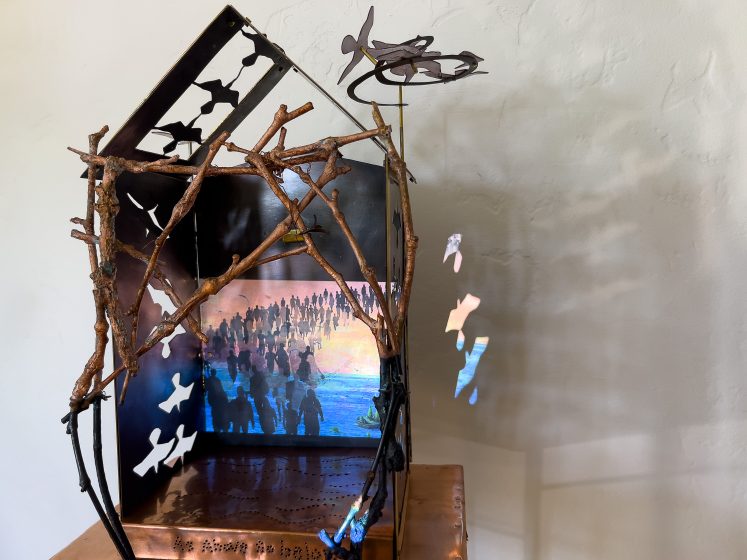

The two artists in this exhibition, Robin Lasser and Sydney Brown, propose that perhaps to live with and through trauma and loss at the global scale, we must first reengage with the body and the senses and get closer and more intimate with the fears and emotions that threaten to overwhelm us. The body of work presented in this exhibition features Lasser’s films projected within and adjacent to memorial structures in the form of homes and water towers created by Brown. Brown’s delicate, semi-abstract copper structures both contain the films and engage in conversation with them, pointing towards the fragility of manmade structures and mankind itself, all the while standing as keepsakes and markers of humans and nature at a critical moment in time. What remains and what gets remembered, kept, treasured, and carried through disaster and loss is all at stake in this installation as together Lasser and Brown gesture at the core concerns, dreams, and nightmares of humanity facing the brink of severe ecological changes and the inherent uncertainties of human-made disaster.
At first glance, Migration Memorial appears as a sketch of an abandoned home, decrepit and overgrown with vegetation. The structure is small and intimate, a stylized house framed with tree branches and cutouts of birds, with a delicately textured surface and burnished seams. The front of the structure is open, leaving a voluminous cube as a surface for projection and shadow play. Paired with Lasser’s films, Shades of Cool Justice and The Storm is Passing Over: Human, Tree, and Bird Migration, shown in a loop, the structure becomes akin to Victorian zoetrope, an early pre-film device that used light, stable images, a sequence of cut-outs, and motion to create the appearance of animation. Allowing the viewer to see a horse or a bird in motion, seemingly at full momentum, by merely peering inside the device and quickly turning it.
While Lasser and Brown’s memorial does not need propulsion on the part of the viewer, it nevertheless mirrors the intimacy of the zoetrope by necessitating an intimate encounter with the sculpture and projections. As the viewer leans in to watch the projected film, they are suffused with the lush, saturated colors and poetic audio of Lasser’s films, each a meditation on the edges and ambiguities between the human and animal world, between loss and survival. In The Storm is Passing Over: Human, Tree, and Bird Migration in the Time of Climate Change, human tree hybrid figures seem to move, in walking and dancing motion, into a desert-like abyss. Is this a voyage of survival or a senseless quest for a safe place to exist? The film does not provide a definitive answer nor a prediction, but in its last minute, a rousing rendition of the hymn “The Storm is Passing Over” by the Plattsburgh Gospel Choir points towards a desire for fortitude in the face of slow destruction. As the choir sings, “The storm is passing over, hallelujah,” trees and humans give way to birds and sea―beyond the desert and the ever-moving mass of migrating bodies is a peaceful sea and a new day.

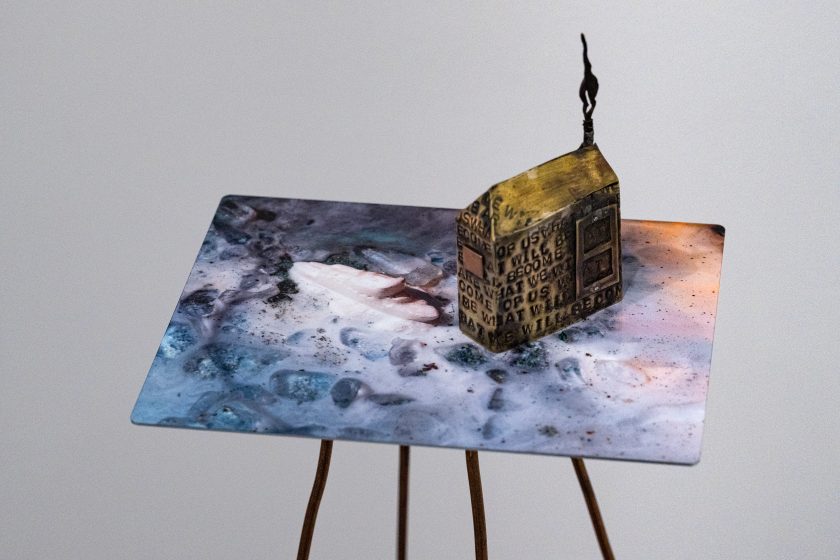
Water for Lasser and Brown is a recurring image that commingles present and past, beauty and loss. Sea Shanty Memorial houses the films Sea Shanty: What of Us Remains? and Requiem: Ice Ships Weep. Here, a stylized house is once again transformed, this time into a sort of underwater reliquary. An abstracted ship and waves decorate the memorial’s surface, while more vessels and waves are projected on top and within it. The work is a melancholy meditation on rapidly changing waterscapes and the artifacts that they hide and reveal. As ice melts and sea levels rise, coastal regions face floods of biblical proportions, while intense drought is experienced in other regions. Too much and too little water, both creating uninhabitable conditions for human and inhuman beings, serve as the focal point in this richly hued series of films, sensual and inviting in their vibrancy and their close-up stop animation style format, while terrifying in their narrative. What of us remains, but also what is the purpose of human-made remnants? What can and do we learn from the excavated remains of submerged vessels? How quickly is the past forgotten?
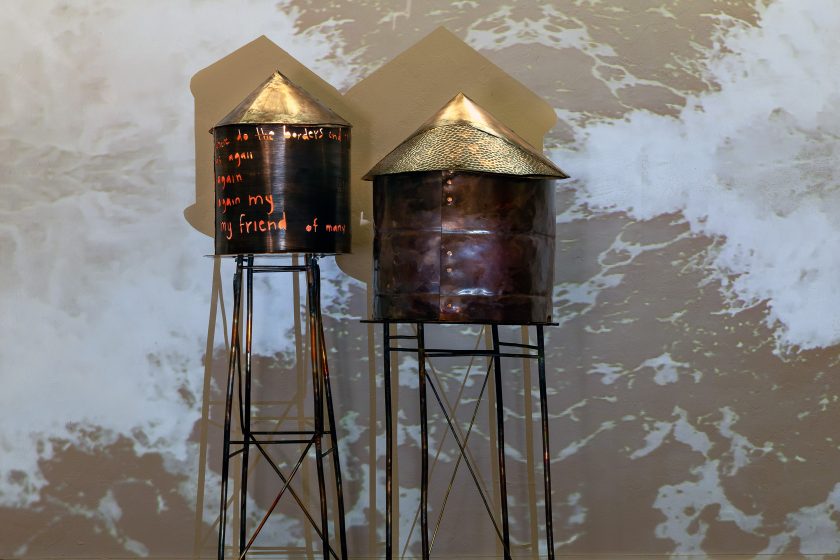
The final work in the series, Water Towers Memorial features the film Weather Report. Breaking from the stylized house shape of the other memorials, this work is instead styled as a miniature water tower, a symbol of technological and urban progress and humanity’s ability to store, possess, and distribute water. A common and familiar sight, the water tower is also an easily ignored one, invisible in its ubiquity. The water tower installation is an ode to water, storms, crashing waves, in the midst of which water towers appear not only small and fragile, as all man-made constructions, but are transformed into memorials to a human-made striving to hold and preserve memory amidst loss.
In creating these works as memorials, Brown and Lasser project beyond the current moment and the climate anxieties experienced by the artists and their audience at a time of increased environmental dangers to consider the aftermath of man-made climate change. What will remain of the earth’s inhabitants, human and non-human, if the dangers of mass global warming, floods, wildfires, and other disasters come to pass? The artists pose questions of themselves and others, but also of the inanimate beings in our surroundings. What will we feel if the Earth keeps warming? What will trees feel?
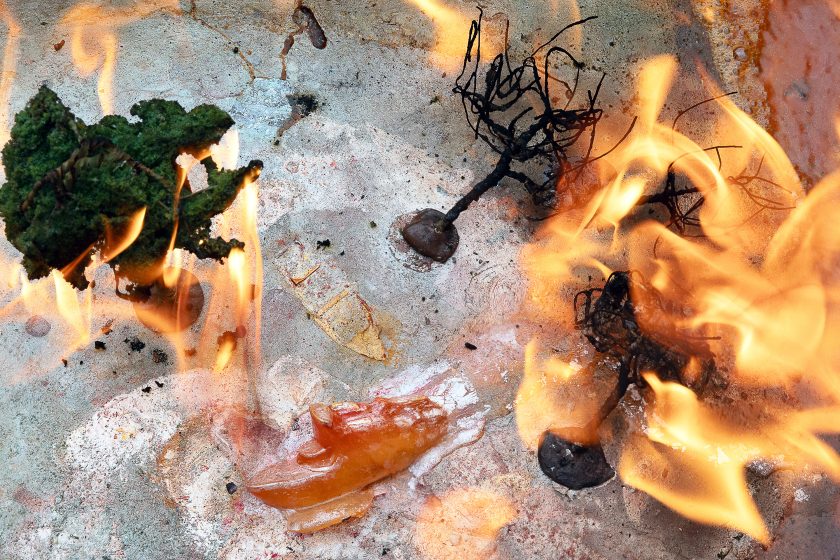
This series of works is prescient not only in its depiction of the aftermath of climate change, but in its consideration of the feelings of foreboding, melancholy, and anxiety experienced by humans as we anticipate the effects of this much-talked-about disaster. As author E. Ann Kaplan theorizes in her book, Trauma Culture: The Politics of Terror and Loss in Media and Literature, narratives of life post climate change apocalypse became a genre of film and literature at the turn of the twentieth century, not just because of the fear of possible world ending scenarios, but as a pre-trauma response of a society that has already started to experience traumatic symptoms. Kaplan proposes the existence of a pre-traumatic stress syndrome, in which the continued exposure to the imminent possibility of future events creates not only a sense of apprehension, but actual traumatic symptoms similar in scope to those of Post Traumatic Stress Syndrome (PTSD), including nightmares, flashbacks, and hallucinations.
While works of film and literature that address the aftereffects of climate change could be interpreted and dismissed as mere fantasy, Kaplan instead argues that these so-called fantasies “function as warnings, a kind of ‘memory for the future’.” Kaplan contends that media images and climate change prediction models are so prevalent and omnipresent in society that they present a kind of cultural trauma, whereby “people live in fear of imminent disaster and fears of future threat dominate consciousness.” Within this framework, works of art do not just propose a possible scenario of climate change, but function as sites where the brimming feelings of loss, fear, and apprehension coalesce and the body pulses with conscious and unconscious sensations. Loss and its effects are felt early, as premonitions and as direct physical sensations: flashbacks, feelings of detachment, vascular pain, trouble sleeping and concentrating, are all established markers of post-traumatic stress, but as Kaplan suggests, these can just as frequently be experienced in anticipation of the prophesied event and in the knowledge that it could happen at any time, and in any place.
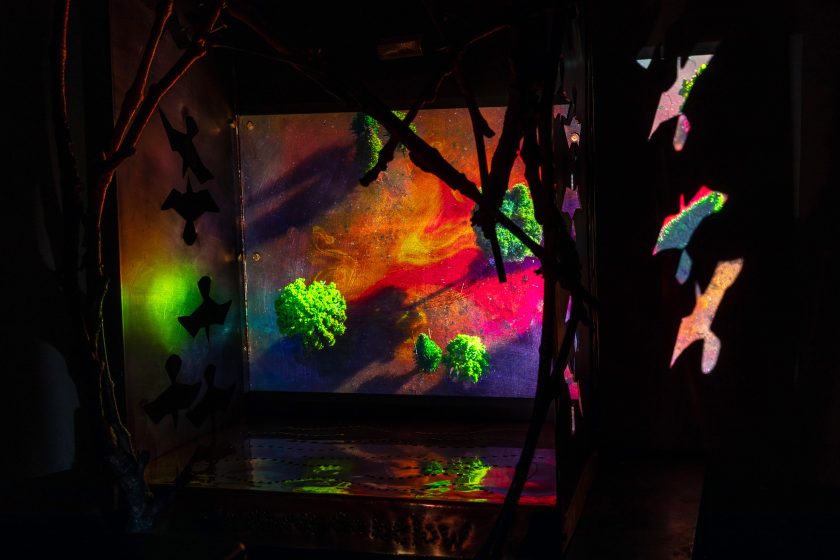
If being bombarded with images of a ruined and devastated planet is what causes these feelings, then why engage with them? Why perpetuate images of devastated landscapes and humans fleeing homes and countries in search of livable places? What can artists offer to contend with not only climate anxiety, but full-scale climate trauma? For Kaplan, the only way out is through, and works of fiction and art are our path towards accepting climate realities and not only managing their symptoms but giving ourselves an active role in the remediation of the planet. She argues that engaging with the imagined outcomes of climate change may be “less a disabling anxiety than a productive warning to bring about needed change.” Therefore, while climate trauma may be triggered by imagining the future of our planet, it may also be lessened over time if it spurs us to wake up and act.
Within the framework of Climate Trauma, Lasser and Brown’s installations are intricate structures that bear the charge of witnessing, memorializing, mourning, and taking action. The memorials in this exhibition expertly utilize the visual language of large-scale public commemorative sculpture, the hard edges, sturdy metal forms, and simple recognizable shapes that have been used for centuries in memorials across the world. However, they also disrupt those same recognizable forms through the interplay of projection and audio on their facades and through an almost shockingly intimate scale. While large scale loss of life is most often commemorated through large scale public memorials, think of the National 9/11 Memorial in New York, the Vietnam Veterans Memorial in Washington D.C., the Oklahoma City National Memorial & Museum in Oklahoma City, or the AIDS Memorial Quilt, Lasser and Brown eschew the desire to equate a memorial’s scale to the the extent of the destruction that it marks. Instead, the intimate scale of the work in the exhibition suggests a different approach to not only commemorating but experiencing the aftereffects of loss. Instead of overwhelming the viewer with larger-than-life forms, the artists invite them to experience thoughts and emotions that may at times conflict with each other, beauty, loss, fear, and enchantment all live side by side within these miniature memorials. The visual appeal of the films, their saturation, and peaceful rhythm meld beautifully with the delicate simplicity of the constructed homes and water towers, and yet, a strong sense of melancholy is present throughout. Loss and foreboding, as well as a knowledge of the fragility of all beings, permeate the work, allowing it to speak to the collective fears and traumas of humanity at the brink of destruction.
How can we commemorate that which is happening all around, as we work to change our fates and the fate of our planet? How do we hold and preserve the remnants of what was lost due to climate change, all the while keeping the knowledge of what is still present and what we must fight to protect? In their depictions of climate change and its effects, real and potential, Lasser and Brown employ a critical lens of ethical witnessing. They consider not only the effects of disaster on their own bodies and those of their loved ones but immerse themselves in the collective nature of climate change. Their shared works speak to the need of humanity to take responsibility for the fragility of our planet and incite action on behalf of the animate and inanimate beings in our midst. In this way, the works stand as essential vehicles for humans to imagine and respond to the dangers and realities of a changing world and to bear witness, before the point of no return, to their own culpability and their own place in the human-made crises at hand.
Alena Sauzade
San Jose




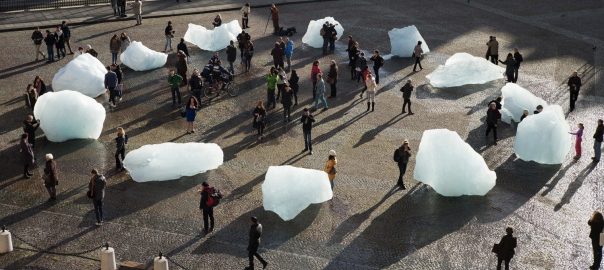
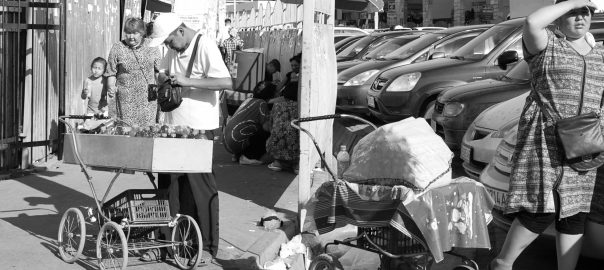

Leave a Reply